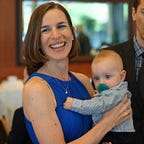The technologies that have transformed our work and personal lives in the past 20 years have not yet transformed healthcare. Doctors and the culture of medicine play a part in this. Because our culture is so different from the corporate culture of the technology world, it’s hard to figure out how to work together to solve hard problems.
For a doctor in their first corporate role, everything can seem new and foreign — from simple things, like how to keep track of our schedules, to the most profound, like what values guide tough decisions.
Using a Calendar is Not So Simple
Take a simple example: Calendars. Coming from a patient care background, it is surprisingly difficult to get used to a calendar of scheduled meetings. Before I joined Suki, the last time I had kept a calendar was my class schedule in graduate school. For years, my day had been entirely governed by the cadence of patient care. Show up, see patients, do what’s needed to advance their care, go home, repeat.
If you work in an administrative role in healthcare or you’ve sold to doctors, you have probably come to expect that doctors will be late to meetings, or not come at all. We are not being intentionally disrespectful. We likely got tied up with a patient. If a patient needs us, it is natural for us to prioritize the patient over the meeting.
Our natural environment is a clinic, operating room, or hospital ward, not a scheduled meeting in a conference room, or on Zoom for that matter. Visitors are usually welcome to meet us in our professional environment (once you get past the facility’s rules). You might be uncomfortable in a fluid patient care setting — but we are comfortable. The best way to find a doctor, if we don’t show up to the meeting, is to meet us where we are.
I have gotten used to running my day according to my calendar now. In fact, it’s insanely back-to-back with our growing team and opportunities, and I take pride in being punctual. When our Medical Director joined the team a year ago, she made a similar adjustment to embrace the calendar. I expect anyone joining a company directly from clinical medicine will have to make this adaptation, and it may not be obvious to others how hard it is — so teammates should be alert to this and have empathy.
Core Values are No Longer Obvious
Another adjustment I made when joining a company from clinical medicine was a calibration on values. The medical profession has a strong, overarching value: The patient comes first. Having the patient’s best interests as our North star makes difficult decisions easier. When in doubt, do what’s right for the patient.
The Quadruple Aim cited by healthcare administrators has never resonated much with me. Stressful situations in particular call for a clear focus. Doctors cannot aim at 4 targets. Our focus is the patient.
I have learned that corporate culture does not, by default, have such a strong, overarching value. Instead, corporate leadership must create a set of values to guide the team toward good decisions. At Suki, we have a set of core values with one value as the first among equals: Every pixel is in the service of the doctor. This helps us align when making hard decisions.
For a doctor coming into a startup, the ambiguity around values can be confusing. I was used to having a clear North star with which to navigate and resolve disagreements. But in the early days of a start-up, well-meaning team members may be operating with different values in mind, each thinking they are doing the right thing.
Data, Meetings, and Actually Building Software
We run into more mundane differences all the time, from the way we use data (doctors will tend to be more academic) to the way we run meetings (medicine has strong rituals and our team syncs require no agenda — think of inpatient rounding, or signing out). When doctors enter the corporate world, it requires effort to learn the expectations of our colleagues in this new environment.
For me, the biggest learning when I joined Suki was how to be realistic about the pace of technical progress. I had little experience working with engineers. How fast could we deliver features? Which features are easy to implement, and which ones are hard (the answer to this will often be surprising, so it’s the conversation that’s key). Learning what to expect — and how to help — took some trial and error. After years of collaboration and the ups and downs of product development, I now understand better how I can help my engineering colleagues find the shortest path to delivering value, while also thinking long-term and building a strong technical foundation for Suki.
How to Overcome Our Differences
For doctors who want to advance technology by working within a company, there is a lot to learn. Similarly, my team members at Suki are making a big investment in learning how to work with doctors, so that we can build tech that serves the medical profession.
There will inevitably be mis-steps and mis-understandings. What to do when we stumble? Keep trying. Acknowledge that we are all learners in this field, and have empathy. When things fall apart, identify the pieces that did work, and build again with those. If we can do this together, we might build something great.
